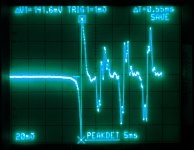I had a real Echoplex made with vacuum tubes back in the late 60's and early 70's. It was severely broken (had been dropped) and it took a took of tinkering to make it work. It had the playback head on a slider to vary the delay time. My DIY attempt in the 80's used a bunch of heads and a speed control on the motor. You can get some really weird sound effects with every other head wired to alternate channels of a stereo playback system.
You will get some rather ugly distortion and oddball frequency response if you don't use a bias oscillator. Old enough to remember those cheap Japanese 3 inch battery portable reel to reel tape recorders from the 60's and their crappy sound? They had no bias, and the erase head was a rotating magnet. The erase head in a modern tape recorder uses a high level signal from the bias oscillator. Use of pure DC will eventually magnetize the head causing information loss every time the tape is played.
Try to use the electronics from the recorder itself if possible. They are already built and optimized for decent sound.
A guitar can put out signals over 1 volt peak to peak. Over 10 years ago there was a thread in these forums, the Hundred Buck Amp Challenge which is now a sticky at the top here. People were asked to design a guitar amp with a total parts cost under $100. Some of the participants had never made a guitar amp before and therefore inquired about the signal levels that come from an electric guitar. I took every guitar I have, put a scope across its output and blasted away on the strings. Here is a scope shot of a single note on the hottest guitar I have, an old Guild with Dimarzio pickups. The scope has a non Tektronix 10X probe on it which the Tek scope did not detect so the actual signal level is over 1.4 volts peak to peak. Blasting out some 6 note chords pushed the output to about 2 volts peak to peak but the scope would not trigger on 6 note chords so I could not get a picture.
If you play anything more than simple quiet notes you will need some compression or signal limiting between the pickup and recorder.
You will get some rather ugly distortion and oddball frequency response if you don't use a bias oscillator. Old enough to remember those cheap Japanese 3 inch battery portable reel to reel tape recorders from the 60's and their crappy sound? They had no bias, and the erase head was a rotating magnet. The erase head in a modern tape recorder uses a high level signal from the bias oscillator. Use of pure DC will eventually magnetize the head causing information loss every time the tape is played.
Try to use the electronics from the recorder itself if possible. They are already built and optimized for decent sound.
A guitar can put out signals over 1 volt peak to peak. Over 10 years ago there was a thread in these forums, the Hundred Buck Amp Challenge which is now a sticky at the top here. People were asked to design a guitar amp with a total parts cost under $100. Some of the participants had never made a guitar amp before and therefore inquired about the signal levels that come from an electric guitar. I took every guitar I have, put a scope across its output and blasted away on the strings. Here is a scope shot of a single note on the hottest guitar I have, an old Guild with Dimarzio pickups. The scope has a non Tektronix 10X probe on it which the Tek scope did not detect so the actual signal level is over 1.4 volts peak to peak. Blasting out some 6 note chords pushed the output to about 2 volts peak to peak but the scope would not trigger on 6 note chords so I could not get a picture.
If you play anything more than simple quiet notes you will need some compression or signal limiting between the pickup and recorder.
Attachments
Last edited:
